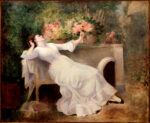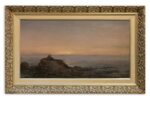Martí i Alsina, Ramón
BIOGRAPHY OF RAMON MARTÍ i ALSINA:
Barcelona 1826 - Barcelona 1894
Painter. Orphaned at the age of eight, despite economic difficulties, Ramon Martí Alsina was able to study drawing at the Llotja school (1840-44) and at the same time obtain a bachelor's degree in philosophy (1845). At the beginning he combined a great activity as a portraitist, especially in Mataró, his mother's hometown, with the translation of books from French and even writing dramas in verse of romantic influence, which were never published.
Married to Carlota Aguiló (1860), Martí Alsina soon after obtained, by competitive examination, the chair of professor of arithmetic and geometry at the Llotja school (1852) and, later, the chair of figure drawing (1854).
During his stays in Paris, he became acquainted with the works of Courbet, who in the mid-nineteenth century had revolutionized the pictorial world of the French capital. This influence led Martí Alsina to create his own style, analytical, of maximum formal realism in drawing, color and light. His subject matter tried to reflect, as objectively as possible, the world around him, that is, the landscape of Catalonia and its inhabitants. At first, Martí Alsina made quick notes, taken directly from nature and then transferred to the canvas. This fact differentiated him from other painters who did not yet feel the need to leave their studios.
Martí Alsina obtained the third medal (1858) and the second medal (1860) at the National Exhibitions of Fine Arts in Madrid.
Elected member of the Academy of Fine Arts of Barcelona (1859), he resigned seven years later (1866), for political reasons derived from his liberal and republican ideas, combined with an atheism often tinged with anticlericalism, as reflected in his writings and some of his oil paintings. The militant attitude he adopted throughout his life led him to resign from the chair of the Llotja school (1870), a chair that was returned to him by the First Republic (1873).
The pure realism, characteristic of Martí Alsina's early days, was replaced in the late sixties by a synthetic, more dramatic style. He also expanded his subject matter: in addition to portraits, landscapes and urban views, he began to produce female figures and nudes, seascapes, still lifes, allegories, scenes of customs and even historical compositions, such as the monumental El gran día de Girona (The Great Day of Girona), almost eleven meters wide.
After the death of his first wife (1878), Martí Alsina lived in Paris for more than a year and visited Belgium and Holland. On his return to Barcelona, he organized different workshops, where the artist's collaborators worked. There they made paintings directed or retouched by the master. However, this system did not work economically, and over time, the prestige of Martí Alsina was affected. It is believed that the number of oil paintings signed by Martí Alsina is around 4,000.
Married in second marriage to Francisca Chillida (1889), in his last years his solitary genius re-emerged, searching for new forms of expression, with an undone brushstroke, close to impressionism.
Martí Alsina's importance is mainly due to his having introduced realism in Catalan painting, but also to his work as a teacher of a whole generation of new painters, to whom he instilled a spirit of renewal. Vayreda, Urgell, Galofre, Tusquets, Pellicer, Torrescassana, Armet and Pahissa, among the best known, passed through Martí Alsina's workshop and were influenced by him.
Martí Alsina has been considered the initiator of the Catalan school of modern painting.
Showing the 3 resultsSortedby the latest



